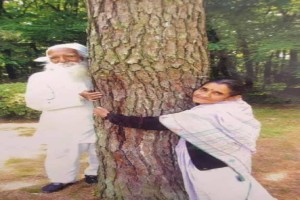
 By Kaushal Kishore*
By Kaushal Kishore*
Bahugunas conveyed their message to restore the Himalayan landscape with fruit bearing trees replacing the pine monoculture as the missing bit of the Chipko movement
On World Culture Day on May 21, 2021, a series of tributes began to pour in as soon as Rajeev Nayan Bahuguna shared about his father on the social media from the AIIMS at Rishikesh. It was an occasion dedicated to the indigenous diversity amidst one of the worst pandemics of history. Cartoonist Satish Acharya depicted a saint merging into the two trees engrossed in talk as a tribute to the Gandhian leader Padma Vibhushan Sundar Lal Bahuguna (9.1.1927-21.5.2021).
One can easily cross the thousand words limit in order to explain the creativity all centred around the Gangaputra. An excellent expression depicting spirit of Satyagraha in post independence days, and I hope it will continue to shine across the Himalayan peaks as long as traditional water rights of the local communities are not actually restored. Public protests to save the Himalayan forests unfolded in 1970s with the Chipko movement, and extended further against Tehri Dam by the following decade. The Gandhian School of Politics disclosed the old colonial injustice of the pine monoculture in the Himalayas in 1952 when Meera Behn (Madeleine Slade) wrote, Something Wrong in the Himalaya. The life and works of Babaji is incomplete without the mention of his wife Smt Vimala Bahuguna, beloved Mataji, the student of Lakshmi Ashram at Kausani in Almora. As a new endeavour on the basic education (Nai Talim) it started in 1946 by Sarala Behn (Catherine Mary Heilemann 1901-1982), one of the two well-known European followers of the Mahatma.
After independence, the state government of Uttar Pradesh invited Meera Behn to help with her expertise in agriculture. This was at the juncture when she was trying to persuade Bapu with funding to start the Ashram in North India. Kisan Ashram, near Roorkee, Pashulok Ashram and Bapu Gram at the outskirts of Rishikesh were her creations in those days. Advent of Frederick Wilson in Garhwal got proper response on 25th March 1974 at Reni, when Gaura Devi with certain other villagers embraced the trees to save them and the celebrated Chipko movement started. The local village Panchayat and Chandi Prasad Bhatt, including Sarala Behn played key roles behind its success. They have focused on most creative rendition of the Rajasthani folk tradition that preserved Khejari trees in the deserts since ages.
In 2008, Bahuguna, an ardent supporter of Aviral-Nirmal Ganga, asked to join him on the visit to Prayag and Meerut. The Allahabad University invited him to a dialogue series on the Ganga. The week long companionship offered many opportunities to share our views. Success saga of the Chipko and failure of the Satyagraha against Tehri Dam were most discussed topics between us. Indeed it was horrific to know that the state sponsored accident in early eighties has prompted him to repeat what Chauri Chaura witnessed during the freedom struggle.
Satyagraha for the Bhagirathi is an extension to the Aviral Ganga Campaign initiated by Mahamana Madan Mohan Malaviya. One can notice it at Bhagiratha Point ever since its creation during the World War I. Agenda of the corporate-state is an open secret in 21st century, however, Prof. G.D. Agarwal tried hard to carry it further in the last phase of his life. What to say on the fate of first member secretary of Central Pollution Control Board (CPCB)? The AIIMS at Rishikesh witnessed that fate of the Gangaputra on October 11, 2018.
Bahugunas conveyed their message to restore the Himalayan landscape with fruit bearing trees replacing the pine monoculture as the missing bit of the movement. Leaves that can resist the rain drops are better than the pine needles, no? This can also prove to heal the old wound in the future. The destruction of Kedarnath in 2013 and recent glacier burst at Tapovan suggest something similar. After the new episode at Reni, tribal communities in Lahaul Spiti district of Himachal Pradesh opposed the hydropower projects in their surroundings. Forest Rights that promote the fundamental role of traditional community in its conservation is again in focus since the United Nations cleared its position on this topic. Unfortunately the political class has surrendered before the ruling class in the post development period, as such it’s not easy for the tribes in the Himalayas to dream what is right and just in these trying times.
In Almora, Basanti Devi was in focus during the Kosi flash flood, almost a decade ago. She has imparted knowledge at Lakshmi Ashram in the eighties. In the age of all pervasive division among the public on religious lines, Forest Rights Movement is a kind of the hope in the mirage. The new generation of the Bahugunas from Tehri, Kishore Upadhayaya has been leading this movement. The Gandhian leaders like Anupam Mishra and Bahugunas are all the more relevant since the Third Pole has turned into the battlefield. They can invite attention from all corners, and rays of hope that can cement the hearts with peace and prosperity rest there alone.
*Kaushal Kishore is the author of The Holy Ganga (Rupa, 2008) and Managing Editor of Panchayat Sandesh, a monthly organ of All India Panchayat Parishad. The views expressed as personal





